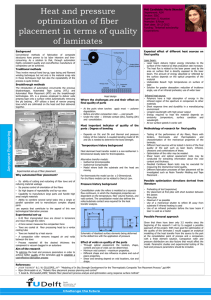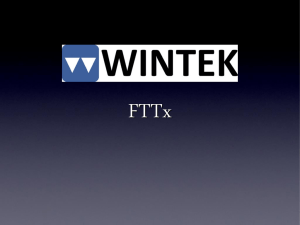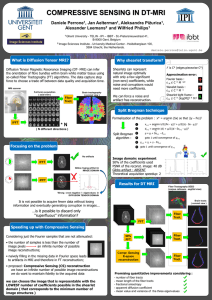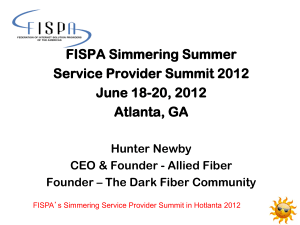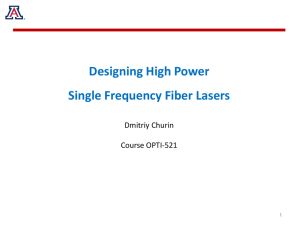MOSTI BGM Project Report Dec 2010
advertisement
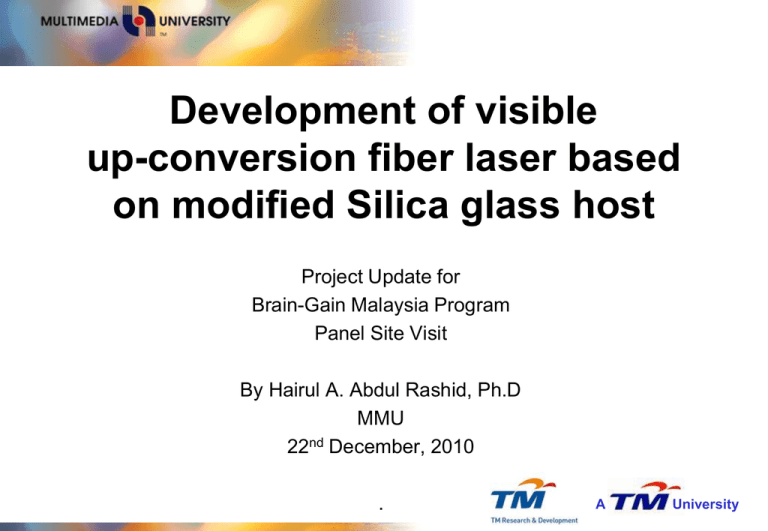
Development of visible up-conversion fiber laser based on modified Silica glass host Project Update for Brain-Gain Malaysia Program Panel Site Visit By Hairul A. Abdul Rashid, Ph.D MMU 22nd December, 2010 . A University Contents • • • • • Introduction Physical Progress Financial Progress Corrective Actions Requests A University Introduction • Design, Fabricate and Characterize: – Visible wavelength – Fiber laser – Modified Silica Host • Under guidance of visiting scientist: – Dr. Mukul Chandra Paul, CGCRI, India • Collaboration: – TM R&D A University Methodology • Development – Preform fabrication – Fiber drawing – Fiber laser setup • Characterization – Fiber dimensions – Emission/ Lasing properties A University Fiber Design • Core composition: SiO2+Al2O3+Yb2O3+Pr2O3+ZrO2/Y2O3+F • Core diameter: 25μm • Inner cladding diameter: 200μm • Coating dia: 400±25μm • Core NA: 0.12 • Cladding NA: 0.45 - 0.49 • Pr and Yb doping level: 1.0 - 1.5 wt% A University Updates • Preform Fabrication – MCVD is ready to run deposition – Not fully sintered – Recipe need to modify – Solution doping - doping of Pr3+ and Yb3+ into alumino-silicate glass modified with incorporation of ZrO2 and PbF2 or F of optical fibre preform. – Solution doping station: • Design complete • motor and pump ready • Preparing tubing A University Set Up For Solution Doping Peristaltic Pump Motor Fabricated porous soot Drain Valve Dopant Solution A University Updates • Fiber drawing – Milling of the preform into D-shaped inner cladding structure – Polishing – Resin coating for outer cladding – Fiber drawing – Drawing tower in UM is not ready (expected February 2011) – Fiber drawing will be done in CGCRI – Quotation ready A University Updates • Fiber Laser setup – Lasing wavelength range:- Visible range (400800nm) – Output Power range:- 0.01-0.1W – Pump configuration with other parameters:Wavelength (800nm or 980 nm), Pump Power (1000mW) A University Characterization Progress Schematic diagram of visible wavelength Pr3+ Doped fiber laser setup There will be three types of pump wavelength to be proposed for this project : 1. 1064nm 2. 800nm A University 3. 980nm Multimode laser diode Uncooled High Power Laser Diode Max Power (10W) High Power Laser Diode Driver (Controller) High Power Laser Detector A University Laser Diode Characteristics 5000 80 4500 y = 0.7183x - 228.28 70 Output Power (mW) 4000 Power (mW) 3500 3000 2500 2000 1500 1000 60 50 40 30 20 10 500 0 0 300 1300 2300 3300 4300 5300 Drive Current (mA) 6300 Bookham 980nm Laser Diode Charactereristics at typical operating current (extrapolated) 7300 0 100 200 300 400 500 Drive Current (mA) Bookham 980nm Laser Diode Charactereristics near threshold current A University Updates • Characterization – Material study of Pr doped modified silica based glass structure using EPMA, SEM-EDX, XRD and TEM analyses – To be done in CGCRI – Quotation ready A University Updates • Characterization • Geometrical and optical property of the fabricated fibres will be done through measurement of core diameter, inner cladding diameter, coating thickness and RI profile using Fibre Analyser along with optical loss by the spectral attenuation set-up. • Setup is ready A University Physical Progress • Original Gantt Chart • Milestone #1 – Complete fabrication – June 2010 – Not achieved (yet) A University Reasons • Milestone #1 not achieved • Dr. Mukul was involved in some industrial accident. • Currently recovering and undergoing physiotherapy • Late disbursement, October 2010 A University Corrective Actions • Necessary equipment and raw materials for fabrication is ready • Dr. Mukul’s trip to Malaysia in January 2011 • Hairul to visit Dr. Mukul (private) • In the mean time, our team is running several runs in the MCVD through his guidance over email. • Start earlier on other project activities: characterization A University Physical Progress • Revised Gantt Chart 2010 # Task Name 1 Setting up solution doping station 2 Fabrication of preform using MCVD method 3 Doping using solution doping 4 Fiber Drawing 5 Fiber optical and physical characterization 6 Visible fiber laser construction and characterizations 7 Analysis of characterization results Oct Nov • Revised Milestone – Milestone #1: March 2011 – Milestone #2: May 2011 – Milestone #3: August 2011 2011 Dec Jan Feb Mac Apr May June July Aug A University Request • Extension: 31st August, 2011 • Fiber drawing and characterization will be done in CGCRI • Team to visit CGCRI in March 2011 • Use existing budget since Dr. Mukul can spend only 2 months maximum A University Financial Progress • • • • Approved Project Allocation : RM_312,100_ Year 1 ( 2010 ) : RM_246,600__ Total Allocation Received To date : RM_246,600_ Total Expenditure To date: RM_ 140,852.45 __or _57.12__% • Balance of Allocation To date : RM_ 105,747.55 A University APPENDIX A University www.physics.unlv.edu/facilities.html Background • Visible laser light sources – Spectroscopy – Printing technology – Medical applications www.physics.unlv.edu/facilities.html A University Background • Currently – air cooled ion lasers – frequency doubled solid-state lasers • Problem – high power consumption – complicated nonlinear parametrical processes • Up-conversion fiber lasers operating directly in the visible spectral range offer a simple alternative A University Advantages • phases of the incident light = phase upconversion light, not required • Lower cost, mature semiconductor laser as pump • Glass hosts as wave guides – increases the optical gain length – decreases the pumped power by the optical restriction effect – beam quality A University Problem Definition • Up-conversion lasers based on glass fibers – high pump intensities over long lengths – laser threshold • silica glass unsuitable due to high phonon energies – cause strong multi-phonon transitions – lead to too short metastable level lifetimes. A University Problem Definition • Alternatively, heavy-metal fluoride glasses (e.g. ZBLAN) – tends to be fragile and expensive A University Solution • fabricate compact, mass-producible, highpower up-conversion visible wavelength fiber lasers • employs cheap, readily available IR semiconductor lasers • research required to identify suitable materials for host • A University Solution • Use Praseodymium (Pr) with Ytterbium (Yb) as a co-dopant – Emission occurs at multiple visible wavelengths including blue/green, green and red – Previous proof of high efficiency upconversion lasing in ZBLAN optical fibres – Use of a single wavelength pumping source when co-doped with Ytterbium (Yb). – The apparent lack of a photodarkening mechanism. A University Modified Host • Fluoride and Tellurite hosts offer better quantum efficiencies – however properties are problematic, non-practical device. • Doping silica materials with Pr3+ or Yb3++Pr3+ – low fluorescence – high phonon quenching • Need for modified silica host A University Objectives • Development of Pr3+ and Yb3++Pr3+ co-doped modified silica based glass host containing around 80-85mol% of SiO2 for use as cladding pump visible up-conversion fibre laser in blue, green and red regions. A University Objectives • Optimization of the core composition of Pr3+ and Yb3+ doped silica glass based optical fibres to improve their lasing property from view point of material study and fibre design. A University Objectives • Standardization of different process parameters during fabrication of preform, milling followed by polishing in the D shaped inner cladding structure and fibre drawing stage to get desired waveguide parameters of the fibres . A University Objectives • Spectroscopy study of RE dope nanocrystallite fibre. • Evolution of the lasing property of the fabricated Pr3+ and Pr+Yb codoped cladding pump fibres. A University Visiting Scientist • • • • • DR. MUKUL CHANDRA PAUL Optical Communication Fiber Laboratory Central Glass & Ceramic Research Institute Expertise - Fiber Optics, Material Science CV attached A University • CGCRI support/ approval A University Methodology • Development – Fabrication – Fiber Laser setup • Characterization – Fiber dimensions – Lasing properties A University Proposed fiber A • Core composition: SiO2+Al2O3+Yb2O3+Pr2O3+ZrO2/Y2O3+F • Core Dia:- 20-25 micron • Inner cladding dia:- 200μm • Coating dia: 400±25μm • Core NA:- 0.12 ±0.01 • Cladding NA:- 0.45-0.49 • Pr and Yb doping level:- 1.0- 1.5 wt% A University Proposed fiber B • Core composition: • SiO2+Al2O3+Yb2O3+Pr2O3+ZrO2+PbF2 A University Project Activities • Fabrication – Doping of Pr3+ and Yb3+ into alumino-silicate glass modified with incorporation of ZrO2 and PbF2 or F of optical fibre preform. – Milling of the preform into D-shaped inner cladding structure – Polishing – Drawing of fibre A University Project Activities • Fiber Laser setup – Lasing wavelength range:- Visible range (400800nm) – Output Power range:- 0.01-0.1W – Pump configuration with other parameters:Wavelength (800nm or 980 nm), Pump Power (1000mW) A University Project Activities • Characterization – Material study of Pr doped modified silica based glass structure using EPMA, SEM-EDX, XRD and TEM analyses – Geometrical and optical property of the fabricated fibres will be done through measurement of core diameter, inner cladding diameter , coating thickness and RI profile using Fibre Analyser along with optical loss by the spectral attenuation set-up. A University Characterization • Study of lasing property of Pr3+ and Pr3++Yb3+ doped fibers • Pumped by 980 nm laser Pr+Yb codoped D shaped low RI coated fiber A University Milestones No Milestones Completion Date Deliverables 1. Complete fabrication June 2010 new modified host glass fiber 2. Complete characterization September 2010 Full characterization results of the visible fiber laser based on the new modified host glass fiber 3. Complete results analysis December 2010 Full analysis on characterization results of the visible fiber laser based on the new modified host glass fiber A University Gantt Chart A University Project Cost Category a) Sustenance (DV, IFPD, B2L, R&D) b) Return Air Fare (DV, IFPD, R&D only) c) Medical Insurance (DV, IFPD, B2L, R&D) d) Top-up project cost (consumables, 1 Research Assistant, equipment rental cost) RM RM 7,000/ man-month RM 7,000 x 6 months = RM 42,000 RM 1,600 X 3 times = RM 4,800 RM 500 X 6 months = RM 3,000 RM257,300 (R&D only) (Please itemized) see below e) Accommodation RM5,000 TOTAL RM312,100 A University Top-up Project Cost • RO Cost = RM 24,000 • Cost related to fabrication RM204,300 • Cost related to characterization RM29,000 A University Benefits No. Impact 1. Enhanced knowledge in fabrication of advanced materials will allow researchers and scientist in to move up the value chain with access to more materials that potentially have numerous applications. 2. With the enhanced knowledge in fabrication, new modified host glass fiber can be designed, fabricated and characterized leading to potential commercialization and quality publication. 3. Success in identifying a suitable host material will allow high-power visible wavelength lasers to be mass-produced. This in turn would allow the creation of a new high-technology laser company which would further increase the Malyasia and profile in this very strategic area. A University Current Facilities • Photonics Lab, TM R&D • Head of Lab, Dr. Abdul Aziz Mat Hassan • Fabrication – MCVD – Quartz Etcher • Preform Profiler A University Lathe A University Bubbler A University Gas Delivery System A University DI Water Facilities A University Gas Farm A University Scrubber A University Preform Profiler A University Current Facilities • Characterization – Visible Spectrometer – Power Meter (High Power) – RF Spectrum Analyzer (Linewidth Measurement) – Beam Profiler A University OSA, TLS, Current Controller A University Power Meter, Attenuator, PD A University Digital Sampling Scope A University LabVIEW Control A University Visible Spectrometer A University Visit to CGCRI, Kolkata • Visit on December 2009 • Discussion with Dr. Mukul Paul, Dr. Badhra • Focus on fabrication and characterization of silica fiber • Facilities: fabrication (MCVD, drawing tower, solution dopping, UV FBG/ LPG), characterization (preform analyzer, fiber analyzer, optical amplifier characterization) A University A University A University A University A University A University A University A University Acknowledgement A University THANK YOU! A University

